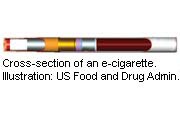- Skip Storing This Everyday Product in the Fridge Door
- Green Tea + B3 Pairing May Boost Brain Health
- Navigating Your Midlife Crisis: Embracing New Possibilities
- City Raccoons Showing Signs of Domestication
- Mapping the Exposome: Science Broadens Focus to Environmental Disease Triggers
- One Week Less on Social Media Linked to Better Mental Health
- Your Brain Changes in Stages as You Age, Study Finds
- Some Suicide Victims Show No Typical Warning Signs, Study Finds
- ByHeart Formula Faces Lawsuits After Babies Sickened With Botulism
- Switch to Vegan Diet Could Cut Your Greenhouse Gas Emissions in Half
Nicotine Poisoning of Infant Highlights ‘E-Cig’ Dangers, Docs Report


The story of a 10-month-old boy rushed to a hospital after ingesting the refill liquid used in e-cigarettes spotlights an emerging safety issue, the doctors who treated him say.
The child recovered. But the consequences of children accidently consuming the nicotine in these refill vials can easily become tragic, Dr. Robert Bassett, of Einstein Medical Center in Philadelphia, and two colleagues report in the May 7 issue of the New England Journal of Medicine.
Just “one teaspoon of a 1.8 percent nicotine solution could be lethal” to a 200-pound person, the doctors pointed out.
The recent rise in such poisonings among children, tied to the surging popularity of e-cigarettes, highlights “the need to educate patients and parents about this danger and advocate for measures that will help prevent potentially fatal liquid nicotine poisoning of infants and young children,” the physicians said.
The Philadelphia case report is hardly an isolated one, experts note. In April, the U.S. Centers for Disease Control and Prevention warned that the number of calls to poison control centers for nicotine poisoning from e-cigarettes has risen dramatically in recent years. Calls related to poisoning from the liquid nicotine used in e-cigarettes ran at a rate of roughly one a month in 2010, but jumped to 215 in February of this year alone.
Even more troubling, more than half (51 percent) of the poison calls involved children aged 5 and younger, while 42 percent involved people aged 20 and older, the CDC said.
“We have not had an unintentional poisoning death from e-cigarettes yet in the United States that we know of, but the potential is there given the amount of concentrated nicotine in these solutions — it would not take a lot for a child death to occur,” Dr. Tim McAfee, director of the CDC’s Office on Smoking and Health, said at the time.
In the Philadelphia case, Bassett and his colleagues said the boy was taken to the hospital after ingesting a “small” amount of e-liquid nicotine bought at a commercial vaping (or “vape”) shop. The liquid contained 1.8 percent nicotine as well as “unknown concentrations” of other chemicals. After drinking the toxic liquid, the boy began vomiting, his heart rate sped up, and he exhibited loss of muscle control, the doctors reported.
The 10-month-old was lucky, however, because he never lost consciousness and his symptoms gradually subsided about six hours after first being admitted to the hospital.
But the physicians who treated him said the case raises troubling issues.
“The [U.S.] Food and Drug Administration does not currently regulate nontherapeutic nicotine; this raises concerns that in the ballooning unregulated liquid nicotine market there may be variability in nicotine dosing and introduction of unintended toxic ingredients,” they wrote.
There’s also a lack of consistent package labeling or child-protective packaging, the doctors noted. Many of the refill vials carry colorful labeling, “suggestions of edible ingredients [‘lemonade’],” and even “visually appealing cartoons” that might attract a child’s curiosity, Bassett’s team said.
Speaking at the time of the CDC’s warning, experts agreed that the danger to children from e-cigarette refills is real.
Dr. Vincenzo Maniaci, an emergency medicine specialist at Miami Children’s Hospital, said that “the concentration of nicotine in these solutions is significant and they need to be made childproof and regulated. Especially for kids under the age of 5, this amount of nicotine can be fatal.”
The CDC’s McAfee noted that the U.S. Food and Drug Administration is planning to propose regulations for e-cigarettes. He added that he hopes these regulations will include how the product is packaged, including childproof caps and warning labels.
“These things can be hardwired into these products, rather than being left to the whim of the manufacturer,” he said.
Poisoning from the liquid nicotine in e-cigarettes can happen in one of three ways: by swallowing it; inhaling it, or absorbing it through the skin or membranes in the mouth and lips or eyes, McAfee said. Once it is in a person’s system, nicotine can cause nausea, vomiting or seizures.
If those symptoms occur, the patient will typically be told to go straight to the emergency room, said Amy Hanoian-Fontana, from the Connecticut Poison Control Center.
If there are no symptoms, then the patient will be told to stay home and the center will call again in a few hours to see how the patient is doing. If liquid nicotine was spilled on the skin, the person should wash his or her skin in lukewarm water for about 20 minutes, Hanoian-Fontana added.
“We want to know what happened, when it happened and if the person is having any effects from the liquid nicotine,” she explained. “Then we are going to make a determination whether this is something we can keep at home, or if they are having severe symptoms we may recommend that they go into the emergency department. It’s very case-based, depending on the situation.”
More information
Visit the U.S. Food and Drug Administration for more on e-cigarettes.
Source: HealthDay
Copyright © 2025 HealthDay. All rights reserved.










